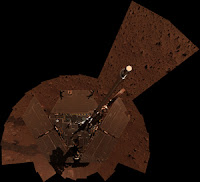The recent questions raised about the notorious "hockey stick" graph (by scientist Michael Mann) are gaining just a little bit more public traction than have other questions raised about global warming over the past few years. Dr. Mann's graph purports to clearly show global warming, and one can imply from the timing of the "warming" that the impact of human activity is at fault. But first amateurs (reminds me of the blogs!) and then mainstream scientists have started to raise questions about Dr. Mann's methodology. The usual response to these sorts of questions in the world of science is to make your methods available for peer review — something that Dr. Mann is apparently refusing to do. Of course, this raises all the more question, as there is no legitimate reason to withhold this information.
In an opinion piece on Friday, the Wall Street Journal briefly tells the story of Dr. Mann's graph, including the extraordinary impact his graph — because of its "clarity" — has had on the impetus behind responding to global warming. They summarize:
But the important point is this: The world is being lobbied to place a huge economic bet — as much as $150 billion a year — on the notion that man-made global warming is real. Businesses are gearing up, at considerable cost, to deal with a new regulatory environment; complex carbon-trading schemes are in the making. Shouldn't everyone look very carefully, and honestly, at the science before we jump off this particular cliff?
Well, that's a valid point all right — $150 billion a year is not chump change by any measure. Of course we should be sure of the science before we place this particular bet (or any like it).
But perhaps a more interesting issue is this: how do we avoid having this sort of tempest-in-a-teacup in the first place? Why is global warming being treated as though it were proven fact, instead of what it really is: an intriguing theory?
I am not a scientist, and I don't even have an opinion about whether global warming is in fact occurring. But it seems to me fairly obvious that the scientists who are investigating global warming have a clear vested interest in the world having great concerns about it. It is this great concern, after all, that causes governments and philanthropic organizations to cough up vast amounts of cold, hard cash for targeted research. Surely it's true that before the scary bogeyman of "global warming", scientists studying climatology didn't have nearly so effective a grant-generating tool. And equally surely, not every scientist (or their manager) is unaffected by this fact. Does anyone doubt that the climatologist whose work spectacularly supports global warming (like Dr. Mann) finds it easier to get grants than the climatologist whose work casts doubt on it? This is a classic setup for producing biased results — a system of incentives for those who produce one outcome, and disincentives for those who produce the other.
And it's exacty what we — the country and the world — don't need: biased information (whether it is flawed or not) to base vital policy-making on. Surely there must be a better way...



